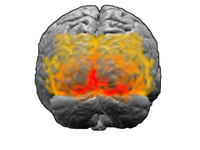
Photo from wikipedia
Human visual perception is modulated by both temporal and spatial contexts. One type of modulation is apparent in the temporal context effect (TCE): In the presence of a constant luminance… Click to show full abstract
Human visual perception is modulated by both temporal and spatial contexts. One type of modulation is apparent in the temporal context effect (TCE): In the presence of a constant luminance patch (a long flash), the perceived brightness of a short flash increases monotonically with onset asynchrony. The aim of the current study was to delineate the neural correlates of this illusory effect, particularly focusing on its dynamic neural representation among visual cortical areas. We reconstructed sources of magnetoencephalographic (MEG) data recorded from observers (6 male and 9 female human adults) experiencing the TCE. Together with retinotopic mapping, signals from different occipital lobe areas were extracted to investigate whether different visual areas have differential representation of the onset vs. offset synchronized short flashes. From the data, TCE related responses were observed in LO and V4 in the time window of 200-250 m s, while neuronal responses to physical luminances were observed in the early time window at around 100 m s across early visual cortex, such as V1 and V2, also in V4 and VO. Based on these findings, we suggest that two distinct processes might be involved in brightness coding: one bottom-up process which is stimulus energy driven and responds fast, and another process which may be broadly characterized as top-down or lateral, is context driven, and responds slower. For both processes, we found that V4 might play a critical role in dynamically integrating luminances into brightness perception, a finding that is consistent with the view of V4 as a bottom-up and top-down integration complex.
Journal Title: NeuroImage
Year Published: 2020
Link to full text (if available)
Share on Social Media: Sign Up to like & get
recommendations!